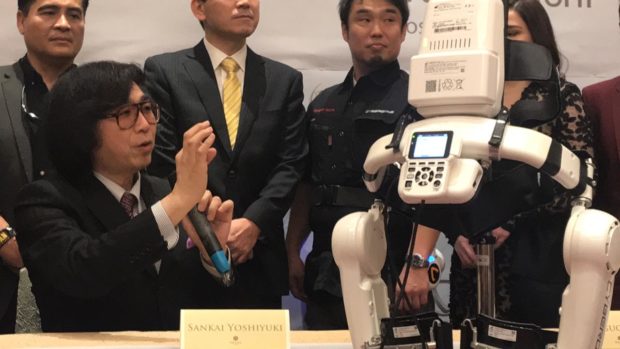Medical firm seeks to partner with gov’t to make advanced PT more affordable

Dr. Yoshiyuki Sankai, President of Cyberdyne, explains to the media how the Hybrid Assistive Limb (HAL) model works to help patients suffering from immobility on April 10, 2019. PHOTO by Christia Marie Ramos/INQUIRER.net
MANILA, Philippines — A medical company is seeking to partner with the government to make advanced physical therapy more affordable and easily accessible to Filipinos suffering from immobility.
The new medical technology created by a Japanese company was formally launched on Wednesday, aiming to help Filipinos with spine injuries.
“Our Japanese partners, Cyberdyne, together with our company, are trying our best to make it affordable for everybody,” Dr. Albert Zarate, President and medical director of Life1 Corporation, said in a press conference.
“That is why initially we said we will be working, hopefully, with PhilHealth and PCSO (Philippine Charity Sweepstakes Office) for patients who cannot afford the technology [or treatment],” he added.
Zarate noted that the partnership between Life1 Corporation and Cyberdyne seeks to “bring aid and assistance to patients who have suffered traumatic spinal injuries and/or who have been rendered immobile by stroke or other diseases with the use of Cyberdyne’s Hybrid Assistive Limb (HAL).”
Article continues after this advertisementHow it works
Article continues after this advertisementDr. Yoshiyuki Sankai, President of Cyberdyne, said HAL had been used extensively in hospital settings.
“Some of the patients in the beginning…uses the wheelchair, but finally, use[d] the cane. So we can change such kind of situations.
Of course, it depends on the disease levels,” he added.
The company claims that HAL is the “only robotic remedial device that can teach the brain how to move the legs.”
According to Cyberdyne, the HAL lower limbs model moves the legs in accordance with the wearer’s intention to walk or stand up and enables timely feedback of the feelings, which consequently “accelerates the learning by the brain.”
The company explained that the major causes of lower limb disabilities are disorders of the cerebral and nervous muscular system, which blocks the brain from using ordinary neutral pathways resulting in its failure to order the legs to move.
All over the country
Zarate mentioned that the proposed medical collaboration with the government aims to place HAL models across the country and cut the cost of each 60- to 90-minute session to less than P3,000.“
Initially, we will be placing it in all the 12 regions of the country plus the National Capital Region. We will be working with all and any hospital that will be interested to bring the technology close to the patients,” he said.
“This is a collaboration, of course, that we hope to make with PhilHealth, PCSO and all the HMOs (health maintenance organizations) in the country,” he added.
Zarate emphasized that the treatment using the HAL model should “not only [be] for the rich, [but] for all patients afflicted with immobility, secondary to an illness, stroke, spinal cord injuries.”
“We hope this to be in public and private hospitals. We hope that all patients can afford it and we intend to spread this to all regions,” Zarate said.
“We like this to be very accessible just like any other medical gadget. And the more we will have government support, the more it will be cheaper and accessible,” he added. “We have seen so many patients who are not able to pay their bills.”
Testing the waters
Zarate said that a hospital in Las Piñas City has already treated 17 patients using the technology.
“So far we started only two weeks ago, and we have already some 17 patients. Different cases,” he said.
He cited a 19-year-old patient with transverse myelitis, or the inflammation of the spinal cord, who was able to walk again after six sessions with the HAL model.
He said that if the technology can allow people who had suffered from motorcycle accidents, vehicular accidents, and gunshot wounds to walk again, then it would be a big help.
Encouraging Filipino patients
Given that HAL is a new medical concept in the country, Zarate said that doctors must first understand the technology to encourage Filipino patients to embrace the treatment.
“They will, in turn, recommend it to their patients,” he said. “If the patients see that that there is an actual improvement, then by word [of] mouth, this technology will prove itself.”
Zarate further explained that the technology gives patients hope that they can recover from immobility, even patients who have been bed-ridden for years. /ee